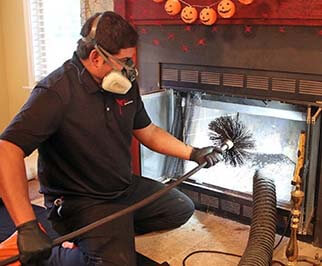
Keeping your home warm and inviting often comes with hidden responsibilities—like ensuring your chimney is safe and clean. One of the lesser-known yet critical reasons for regular chimney cleaning is to protect your family from the dangers of carbon monoxide poisoning. This silent killer can infiltrate your home without warning, and your chimney plays a pivotal role in either preventing or permitting it.
Let’s explore how chimney cleaning is not just maintenance—it’s a vital safeguard.
Why Chimney Cleaning Matters
Carbon monoxide (CO) is colorless, odorless, and incredibly dangerous. It’s produced when fuels such as wood, gas, or coal don’t burn completely. Your chimney’s job is to vent this gas safely outside—but if it’s obstructed, cracked, or caked with debris, CO can seep back into your home.
Regular chimney cleaning, especially from trusted experts, ensures your chimney remains a clear passage for harmful gases. Whether you have a wood-burning fireplace or a gas-fueled insert, neglecting chimney maintenance can lead to dangerous results.
The Risk of Creosote Buildup
Creosote is a dark, tar-like substance that builds up inside your chimney with every fire. Not only is it highly flammable, but it can also restrict airflow, trapping gases inside your home. A chimney clogged with creosote increases the risk of both fires and carbon monoxide poisoning.
Blockages and Animal Nests
Birds, squirrels, leaves, and other debris often find their way into uncapped chimneys. These obstructions can stop smoke and gas from escaping, forcing them to backtrack into your living room. Cleaning removes these blockages and prevents animals from making your chimney their cozy winter retreat.
Structural Damage and Leaks
Cracks in the flue liner or moisture damage in the chimney’s structure can create unseen pathways for CO to enter your home. A professional chimney inspection paired with thorough cleaning helps identify these vulnerabilities before they become dangerous.
When and How to Clean Your Chimney
Keeping your chimney in top shape doesn’t need to be overwhelming. With a seasonal schedule and professional help, your fireplace can remain both functional and safe.
Frequency of Cleaning
Experts recommend at least one chimney cleaning per year—more often if you use your fireplace regularly. Homeowners in areas with heavy seasonal use should consider bi-annual inspections.
Most professional chimney sweeps offers customized services based on your chimney’s age, usage, and condition, ensuring you receive the right level of care.
Choosing the Right Professionals
Not all chimney sweeps are created equal. Look for certified professionals with a strong local reputation, like those listed on reputable sources, who combine modern tools with seasoned expertise to deliver a thorough cleaning and inspection.
DIY vs. Professional Cleaning
While some homeowners attempt DIY methods, chimney cleaning is a complex task that often reveals issues invisible to the untrained eye. Hiring a pro ensures that blockages, creosote, and structural issues are addressed properly.
The Bigger Picture: Safety, Efficiency, and Peace of Mind
A clean chimney does more than protect against carbon monoxide—it improves your fireplace’s performance, lowers your energy bills, and adds value to your home. Think of chimney cleaning not as a chore, but as a crucial investment in your family’s safety and comfort.
Enhancing Airflow and Efficiency
A clean chimney allows smoke and fumes to exit swiftly, which improves your fireplace’s draft and reduces smoke inside the house. Better airflow means better heat output and more efficient fuel usage.
Prolonging Your Fireplace’s Lifespan
Regular cleaning prevents corrosion, blockage, and fire damage, ultimately extending the life of your fireplace system. Neglected chimneys often need costly repairs that could have been avoided with a simple sweep.
Peace of Mind During Winter Months
When temperatures drop and your fireplace becomes the heart of your home, you want the assurance that every flickering flame is safe. Professional cleaning provides that peace of mind, letting you enjoy the warmth without worry.
Frequently Asked Questions (FAQs)
Q: How do I know if my chimney needs cleaning?
A: If you notice a strong odor, excessive smoke, or a black, tar-like substance in your fireplace, it’s time for a cleaning.
Q: Can carbon monoxide detectors replace chimney cleaning?
A: No. Detectors are essential safety tools, but they only alert you after CO is present. Cleaning prevents the issue from arising in the first place.
Q: What’s the best time of year to schedule a chimney cleaning?
A: Late summer or early fall is ideal—before the heating season begins and chimney sweep schedules fill up.
Q: Are gas fireplaces also at risk for carbon monoxide leaks?
A: Yes. Any fuel-burning appliance, including gas fireplaces, needs a functioning venting system to prevent CO buildup.
Final Thoughts
Chimney cleaning is more than routine maintenance—it’s a protective measure for your household. Trust in seasoned professionals, schedule regular cleanings, and take the silent threat of carbon monoxide seriously. A clean chimney is a safe chimney. Let your fireplace be the heart of your home—not a hidden hazard.


